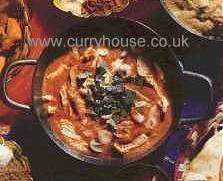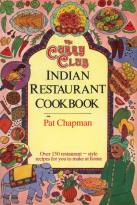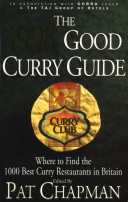
I came across Pat while he was in the middle of a cookery demonstration. When he had finished and the satisfied audience had had a taste of his cooking I asked him if he would mind doing an interview for The Curry House. Luckily for me he kindly agreed.
It was founding The Curry Club that first brought Pat into the public eye. I asked him if he was still involved with the Club as much these days. "Iím the founder of it" he says "but I donít own the brand name any more. Itís now at G.Costa". So is he involved at all now? "Yes, I still do the things that they donít want to do. Iím their consultant. Things like cookery courses and talking to people like you" Thanks a lot Pat. Pat Chapman has a varied life. He is an author, journalist, chef, television cook, cookery demonstrator, consultant for G. Costa and patron of The Curry Club. Which of his roles, I wondered, takes up most of his time? "Writing and demonstrating" he says "writing first and demonstrating second". I explain to him that I have written a few recipes for my Web site and that I found it very difficult to write something that people can understand and follow. "Yes it is difficult" he agrees "and you have to be very disciplined. Itís like a text book, youíre going to be examined by people and theyíre going to write to you and say Ďthat doesnít workí. If it doesnít work, and if something catastrophically doesnít work, you donít sell books. Itís as simple as that. Iím delighted to say that Iíve got books that are still in print after 17 years. Iím very lucky. People have taken to my style of doing things and Iím demanded. So thatís exceeding lucky". And what about other peoples cookery books? "There are many writers who donít even test recipes let alone go out and cook them" he complains "but if you stand at a demonstration for 6 hours at a slog itís a way to test things. You learn a special discipline and also you find out what of your own stuff works let alone other peopleís". He continues "At one stage we had a shop in Covent Garden called The Curry Shop and we did a weekly club there for 50 people. I used to take other peopleís cook books and cook from them. And you find out that some of them didnít work (mentioning no names of course)" I encourage him to name names but he diplomatically declines. Shame, I thought I was going to get a juicy story there. In the introduction to 1998 Good Curry Guide, edited by Pat, it seemed to me that he is having a bit of a dig at Madhur Jaffrey about her Ďconversioní to Balti. Whatís the story on that one I ask him? "No! It is fact" he chuckles "She used to say to me she hated all the restaurants in England. She put that in The Radio Times. That they werenít authentic. And that Balti doesnít exist. And the next thing I find Iím on a television programme with her. Iím cooking Balti thinking Iíll get big stick from her and she wants her Balti pans, which sheís endorsed, brought into the studio. So, yes, sheís a convert. Fair enough. She also is not quite so derisory about the word Ďcurryí because she now endorses Tildaís curry sauces. Itís funny that isnít it?" Absolutely. At the mention of ready-made curry sauces I shiver. I have recently conducted a tasting session of some of the most popular curry sauces and was disappointed with most and disgusted by some. What was Patís opinion I wondered? "I donít like curry ready-meals and curry sauces. The thing is the further they get away from the right way to make it the worse they get it seems to me. And the right way to make it is for intimate cooking and grinding of the spices, you know intimate contact with heat in the pan with relatively small quantities. But unfortunately the big manufacturers do it in 5000 litre vats and give it, you know, 10 seconds for the spices to cook and then pile in the next load of ingredients. So you get that, oh I donít know, that raw taste. It doesnít work". There speaks an expert. Iím glad Iím not alone. Pat is warming to his theme now, he continues "The other thing I get increasingly, whatís the word?, observant about (lets not be emotive) is the addition of additives like acetic acid, preservatives and stabilisers. And Ďuse byí dates on things like, say, mango chutney which simply doesnít need it. Iíve just finished a jar of 15 year old chilli pickle that was in a huge 2 litre jar which came from India and doesnít have any preservatives and, of course, would have lasted for considerably longer. Thatís where I think the journalists should be concentrating their efforts - in the factories. Not on what the restaurants are doing which is passable and very good in some cases whether itís authentic or not".
We move on to that hoary old chestnut - the image of curry houses as being a place to go after a long night at the pub. I tell Pat that I believe that is changing, almost gone now. Does he agree? "I wish it had" he sighs "The whole purpose of writing 600 pages of The Good Curry Guide is to try and get away from that image but journalists and others think the image is rather enduring. I suppose it started back with the British Raj. They were very snobby and looked down their noses at the food and I think itís had that reputation all that time" Does he think that this downmarket reputation will improve over time? "I donít know. People like you and me would make it change if we could" he says sounding rather weary.
We have covered some interesting subjects but now itís time for a bit of fun. In The Good Curry Guide Pat says he would ask Sue Lawley if he could take Southall as his luxury item on Desert Island Discs. I paint him a picture that he is stranded on a desert island and that he can find onions, ginger and garlic growing there. What 5 spices would he like to have with him? "Oh! coriander, turmeric, cumin, chilli (mustnít forget chilli) and ... Iíve got a spare. Mmmm, something aromatic, cardamons perhaps" Good choice I say. Pat has to leave now but I throw in one last question. What about the Internet? Is he going to publish his books online in future? The reply is a resounding NO. "I donít think books will ever be replaced by electronics. I really, really donít. Books feel good. They are nice to hold. Especially cookery books with photographs. A Web site has its uses. I donít even write the [Curry Club] web site, itís done at G.Costa. Iíve got recipes on it and I donít even know which ones!" He reminds me again that he works "25 hours a day" and is really too busy at the moment to get involved in the Internet. I take my cue and let him get back to his busy day.
Copyright David W Smith, 1999
|




